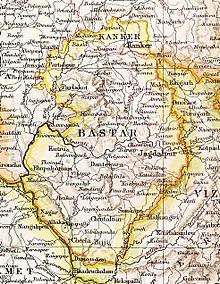User:Adbh266/sandbox/Kamal Chandra bhanj deo Kakatiya
| Bastar State | |||||||
|---|---|---|---|---|---|---|---|
| Princely State of British India | |||||||
| 1324–1948 | |||||||
|
Flag | |||||||
 Bastar State in the Imperial Gazetteer of India | |||||||
| Capital | Jagdalpur | ||||||
| Area | |||||||
• 1901 | 33,831 km2 (13,062 sq mi) | ||||||
| Population | |||||||
• 1901 | 306,501 | ||||||
| History | |||||||
• Established | 1324 | ||||||
| 1948 | |||||||
| |||||||
| Bastar Princely State | |||||||

Kamal Chandra bhanj deo Kakatiya is a Indian Politician [1]and decent of Kaktiyas. After the defeat of King PrathapaRudra by Delhi sultans his brother Annamadeva went and Established his kingdom near the banks of Indravathi river, this region is today Known as Bastar. During Britishers his heirs served as rulers of princely state[2]. The 22nd heir of Kakatiyas HH Maharaja Kamal Chandra dev kakatiya is the present ceremonial ruler of Bastar from the age of 12 years and is considered as "The Living God of Tribals"[3].Maharaja Kamal Chandra bhanj deo kakatiya also served as Chairman of "Chattisgarh state Youth Commission". He is currently continuing in Annamadev’s lineage. Jagdalpur fort is home to the Kakatiya traditions and glories of local festivals.[4]
Bastar state
[edit]Bastar state was a princely state in India during the British Raj. It was founded in the early 14th century, by Annamadeva brother of Prataparudra II. Today the region is called as Bastar division in Chhattisgarh state.
In the early 19th century the state became part of the Central Provinces and Berar under the British Raj, and acceded to the Union of India on 1 January 1948, to become part of the Madhya Pradesh in 1956, and later part of the Bastar district of Chhattisgarh state in 2000. The current ceremonial ruler is Maharaja Kamal Chandra Bhanj Deo kakatiya, of the Kakatiya and Bhanj dynasty.
Bastar state rulers
[edit]- Annam Dev (1324 - 1369) - brother of the Kakatiya Raja of Warangal, Pratap Rudra Dev
- Digpal Deo (1680 - 1709)
- Rajpal Deo (1709 - 1721)
- Mama (1721 - 1731)
- Dalpat Deo (1731 - 1774)
- Daryao Deo (1774) and (1777 - 1819)
- Ajmar Singh Deo (1774 - 1777)
- Mahipal Deo (1819)
- Bhopal Deo (1830 - 1853)
- Bhairam Deo (27 Aug 1853 – 20 Jul 1891)
- Rudra Pratap Deo (20 Jul 1891 - 1921)
- Prafulla Kumari Devi (Rani) (23 Nov 1922 – 28 Feb 1936) - married Prince Prafulla Chandra Bhanj Deo of Mayurbhanj)
- Pravir Chandra Bhanj Deo (28 Oct 1936 – 1948)
- Titular
- Pravir Chandra Bhanj Deo (1948 - 25 March 1966)
- Vijay Chandra Bhanj Deo (25 March 1966 - 12 April 1970)
- Bharat Chandra Bhanj Deo ( 12 April 1970 - 1996)
- Kamal Chandra Bhanj Deo (1996 - current)
Early life of Kamal Chandra Bhanj Deo
[edit]Kamal Chandra Bhanj Deo was born in the year 1984 March 13 to Vijay Chandra bhanj deo kakatiya and Rajamatha krishna kumari devi. He has one sibling by name Rajakumari Gayathri devi. He did his Msater of Science from Coventry University and he also have a degree in Political science from St. Joseph's college of commerce in Bengaluru.He is proficient in many languages
Origin of the word Deo/Dev as surname
[edit]The Bastar region was an outpost of Trikalinga and a part of the larger Kalinga kingdom.During the years 1891-1921, Maharaja Rudra Pratap Dev was the ruler of Bastar. His daughter Prafulla Kumari Devi took up the responsibility as the ruling queen of Bastar. She married Prafulla Kumar Bhanj Dev of the 'Mayurbhanj' royal family of Orissa. Instead of the queen moving to Orissa, Prafulla Kumar Bhanj Dev moved to bastar and stayed along with her. From then on, 'Bhanj', became a suffix as a surname for all the kakathiya descendants.
Career
[edit]Kamal Chandra Bhanj Deo started a non-profit organization called, 'Pravir Sena'. Kamal while serving as the chairman of Chhattisgarh state youth commission (which is a cabinet post of state government) has extensively worked on youth empowerment in terms of skill development and providing employment to youth of Bastar division. He is immensely popular among his people, as he took up the cause of the local tribal people, and provided political leadership.
Bastar Dusshera
[edit]Bastar Dussehra is the unique cultural trait of Chhattisgarh Celebrated by the local people of the state with sufficient vigor. The festival of Dussehra connotes to the supreme power of goddess Danteswari. During Dussehra, the inhabitants of Bastar organizes special worship ceremonies at the Danteswari temple of Jagadalpur.on this occasion rath is made in which the goddess sits .
History of Bastar Dusshera
[edit]
[5]It is said that the Kaktiya ruler King Purushottam Deo in 15th century AD went to the holy shrines of Jagannath Puri temple. During his return he returned as ‘Rath-pati’ with a divine permission to mount on Chariot. From that day this festival is celebrated every year with great zest and enthusiasm. Uniqueness of Bastar Dussehra is

unlike Dusherra celebrated in other parts of our country here it is not celebrated to celebrate the victory of Lord Rama over Ravana. In short it has nothing to do with Lord Rama. Instead it is celebrated as a congregation of native goddess of tribals of Bastar, Devi Mavli and her sisters.
Re establishing the past glories
[edit]After 700 years representatives from Government of Telangana state went to Bastar region and invited the present Heir of Kakatiya Maharaja Sri kamal Chand bhanj dev as a cheif guest for Kakatiya Sapthaham[6].[7]
References
[edit]- ^ "bastar-maharaja-to-join-active-politics". Pioneer.
- ^ "living-god-of-Bastar-tribals". newindianexpress.
- ^ "indian express".
- ^ "Chhattisgarh State website".
- ^ Rahul Pandita (2011). Rahul Pandita. Hello Bastar: The Untold Story Of India’s Maoist Movement. pp. chapter 6. ISBN 978938065834.
{{cite book}}: Check|isbn=value: length (help) - ^ "kakatiya-descendent-to-check-out-warangal". .telanganatribune.
- ^ "-kakatiya-descendent-to-visit-warangal". The Hans India.

